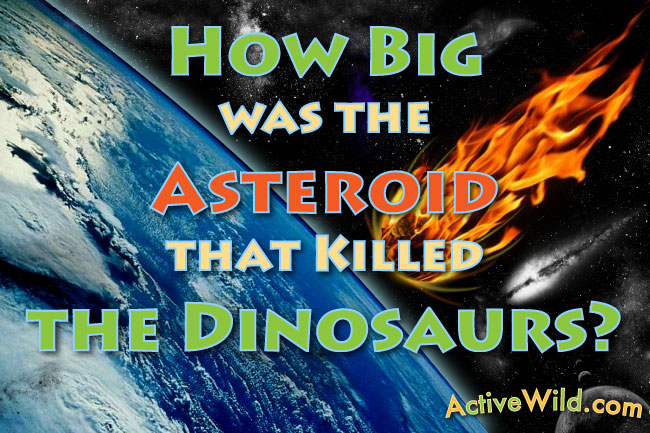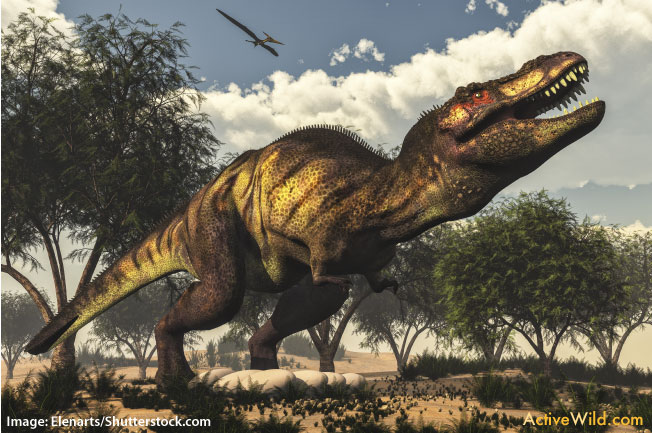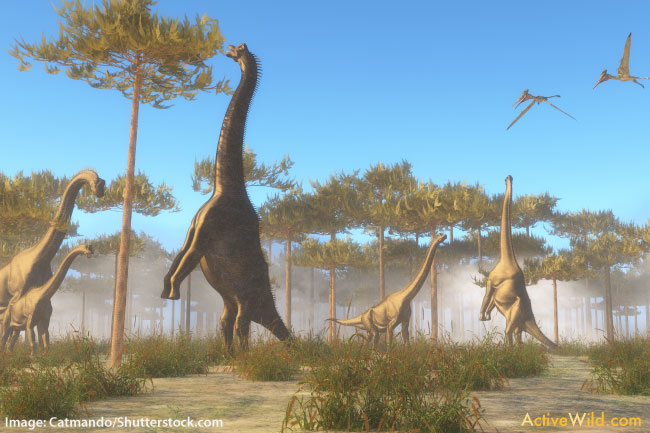How big was the asteroid that killed the dinosaurs? On this page we’re going to investigate one of the most likely explanations for the sudden extinction of the dinosaurs: an asteroid collision.
At the bottom of the page you can see a map showing the point at which scientists believe the asteroid hit Earth.
This article is part of our Dinosaur Facts series.
How Big Was The Asteroid That Killed The Dinosaurs?
If you’ve found this page simply wanting to know how big the asteroid that killed the dinosaurs was, here are the basics:
- The asteroid believed responsible for the Cretaceous–Paleogene Extinction Event is estimated to have been between 10 and 15 kilometres (6 and 9 miles) across.
- A common comparison is that the asteroid would have been ‘the size of Manhattan’.
- Other comparisons are the Martian moon Deimos, which is 12 km (7.5 mi), and Mount Everest, which is around 9 km (5.5 mi).
- The asteroid would have been travelling at around 20 kilometres (12.5 miles) per second, or 72,000 kilometres / 44,712 miles per hour.
- The impact would have caused an explosion equivalent to 100 million megatons of TNT (4.2×1023 Joules)
- For comparison, this is over a billion times the energy of the atomic bombs dropped on Hiroshima and Nagasaki, or around 2 million times more powerful than the most powerful thermonuclear bomb ever tested.
- The impact would have displaced around 200,000 cubic kilometres (48,000 cubic miles) of sediment.
Let’s now find out more about the asteroid strike theory …
Cretaceous–Paleogene Extinction Event
Ever since the realisation that many years ago, huge, reptilian animals walked the Earth, scientists have been trying to find out what caused them to become extinct.
Palaeontologists discovered that after a point around 66 to 65 million years ago there were no more dinosaur fossils. But what had caused this mysterious disappearance?
One way in which scientists date the history of the world is by using the geological time scale. In this system, each geological period correspond to a particular layer of rock. The deeper a layer of rock is found, the earlier it was formed.
Due to a lack of dinosaur fossils occurring in rocks formed after the Cretaceous period, palaeontologists realised that at the end of this period, the Earth had undergone a mass extinction event.
This became known as the Cretaceous–Paleogene (K–Pg) Extinction Event. Something had caused the sudden disappearance of dinosaurs and many other types of animal.
How Big Was the Asteroid That Killed the Dinosaurs: The Alvarez Hypothesis
Over the years, many theories as to why dinosaurs went extinct were put forward (including some that suggested an asteroid strike), but none offered a entirely satisfactory explanation.
Then, in 1980, a team of scientists led by father and son Luis Alvarez and Walter Alvarez put forward what is now known as the Alvarez Hypothesis.
Although it wasn’t the first dinosaur extinction theory that involved an asteroid strike, it was the first to connect a possible strike with geological evidence discovered in the K-Pg boundary.
The K-Pg Boundary
The K–Pg boundary is a thin band of rock that occurs between Cretaceous and Paleogene rocks. The Alvarez team found that it contained a high amount of iridium, a rare metal. One of the few places in which Iridium is found in similar quantities is in asteroids.
Because of this, the Alvarez team suggested that around 65 million years ago Earth was struck by a large asteroid. They calculated that such as asteroid would have been between 10 and 15 kilometres (6 and 9 miles) across: around the size of Manhattan.
An impact of this magnitude would have caused a huge cloud of dust to be thrown into the air.
This would have stayed in the atmosphere for several years, blocking the sun and preventing plants from growing. Plant-eating dinosaurs would have been directly affected. Without plant-eaters to prey on, meat-eaters would also have starved.
Slowly the dust cloud would have settled, forming the K–Pg boundary.
Where Did The Asteroid That Killed The Dinosaurs Hit Earth?
The map below shows the point at which scientists think that the asteroid that killed the dinosaurs hit Earth.
The Chicxulub Crater
When the Alvarez Hypothesis was put forward, it wasn’t known just where the asteroid had hit the Earth.
However, at around the same time as the Alvarez team were researching their theory, a geophysicist named Glen Penfield came across evidence of a huge crater buried underneath the Yucatán Peninsula in Mexico. Roughly in the centre of the crater was the town Chicxulub, which now gives the crater its name.
(The town is marked on the above map.)
The Chicxulub Crater is more than 180 kilometres (112 miles) in diameter and 20 km (12.5 miles) in depth. It is buried at the level of the K–Pg boundary.
Together with fellow geophysicist Antonio Camargo, Penfold published his findings. However, it wasn’t until the nineties that scientists realised that the size and age of the Chicxulub Crater fitted the Alvarez theory perfectly.
The Chicxulub Crater provides us with strong evidence that the Cretaceous–Paleogene Extinction Event was caused by a giant asteroid.
How Big Was the Asteroid That Killed the Dinosaurs: Conclusion
We hope that you’ve enjoyed reading about the dramatic end to the age of the dinosaurs. That science can piece together the events of millions of years ago is truly amazing.
You can find out more about dinosaurs on the following pages:
- Find out more about dinosaurs by visiting our main Dinosaur Facts Page.
- Find out about the Triassic, Jurassic and Cretaceous Periods here: Dinosaur Periods.
- Discover the many different types of dinosaur here: List of Dinosaurs.




